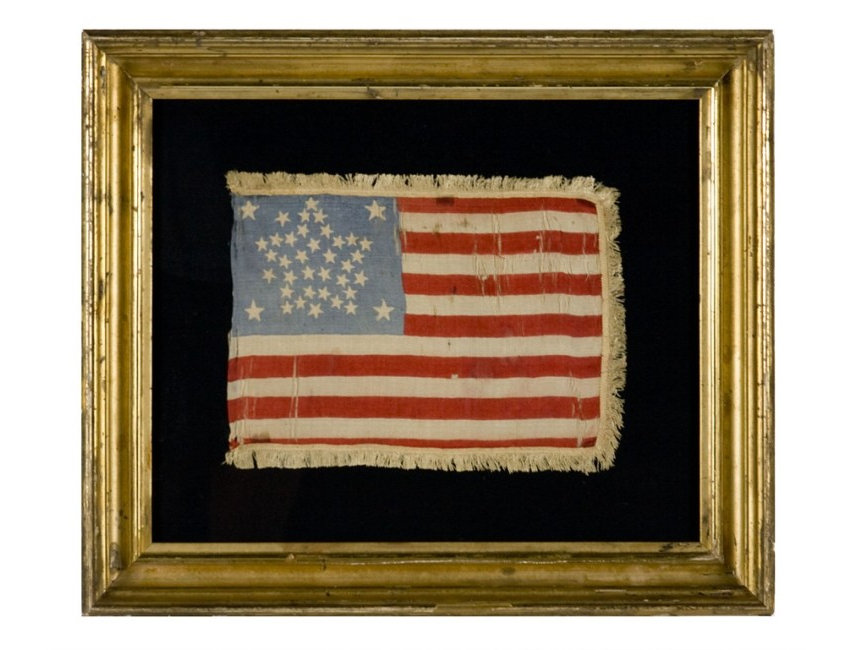|
38 STARS IN A RARE GREAT STAR PATTERN, A SILK PARADE FLAG WITH GOLD SILK FRINGE, COLORADO STATEHOOD, 1876-1889
|
|

|
Description: |
|
38 STARS IN A RARE GREAT STAR PATTERN, A SILK PARADE FLAG WITH GOLD SILK FRINGE, COLORADO STATEHOOD, 1876-1889:
38 star American National parade flag, printed on silk. The stars are arranged in what is known as the �Great Star� pattern, a large star made out of smaller stars. The Great Star comes in many forms. This particular variation consists of a wreath of 5 stars in the very center, which is surrounded by an outline of 25 stars in the shape of a 5-armed star.
This is a very interesting variety for two reasons. One is the presence of a large, flanking star in each corner of the light blue canton. These four stars are not its most unusual feature, but their presence and their larger size adds significantly to the flag�s whimsical nature. But much more intriguing are the 4 stars set between the arms of the Great Star. These are called �outliers�. In this instance, note how the design is unbalanced because one such space was left open, between the arms that point in the 12:00 and 2:00 positions. This was evidently done on purpose, leaving room for the addition of a 39th star. It was fairly common for flag-makers to make design choices like this during the latter half of the 19th century, when flag production increased dramatically to meet the demand of consumption by private individuals and the number of states continued to grow with Westward Expansion.
In addition to the Great Star design, another peculiar feature of this flag can be found in the presence of a fine silk fringe, gold in color, that is hand-sewn along three sides. Parade flags with silk fringes are very rare and attractively different, a fact substantiated by this flag, which has a striking presentation.
Among flag collectors, the Great Star configuration is the Rolls Royce of all 19th century geometric patterns. It probably came about shortly before 1818, when Congressman Peter Wendover of New York requested that Captain Samuel Reid, a War of 1812 Naval hero, help to create a new design that would become the third official format of the Stars & Stripes. The primary concern of ship captains was that the signal remained easily recognized on the open seas. Reid�s concept of placing all the stars in a star-shaped pattern would have kept the constellation in roughly the same format as the number of states grew and more stars were added, in a distinct design that could be quickly identified through a spyglass. Though his proposal was rejected by President Monroe, due to the increased cost of arranging the stars in this manner, the Great Star was produced by anyone willing to make it. Its rarity today, along with its beauty, has driven its desirability among collectors.
The 38th state, Colorado, gained statehood on August 1st, 1876. The flag was official from July 4th, 1877 � July 3rd, 1889. Because flag-making was a competitive venture, no one wanted to be making 37 star flags when others were making 38�s. Flag-makers paid little heed to official star counts and would have begun producing 38 star flags for the centennial sometime in the early part of 1876. This flag was probably produced in that year, both because the medallion and Great Star patterns are extremely rare after the centennial, and because flag makers used more interesting designs in celebration of the Nation�s 100-year anniversary of independence.
Mounting: The gilded, American molding dates to the period between 1840 and 1870. This is a sandwich mount between 100% cotton and U.V. protective acrylic. The black fabric was washed to reduce excess dye. An acid-free agent was added to the wash to further set the dye and the fabric was heat-treated for the same purpose.
Condition: There is some breakdown in the silk fabric. A length of white silk was placed behind the flag, both for masking purposes and to strengthen its color against the black background. There are moderate stains in the top center, the top and bottom corners of the fly end, and the lower corner of the hoist end, accompanied by minor staining elsewhere throughout. The canton was probably dark blue initially and faded to the current color. Many collectors prefer early flags to show their age and history of use. Further, the rarity and beauty of flags with the Great Star pattern warrants practically any condition. |
| Inventory Number: |
|
|
|
Dealer |
Jeff R. Bridgman American Antiques, llc |
| Contact |
Jeff Bridgman |
Phone: (717) 502-1281 |
|
| Period: |
18th Century (1701-1800) |
|
| Date: |
1876-1889 |
|
| Origin: |
American |
|
| Condition: |
see description |
|
| Measurements: |
flag: 7.5" x 9.75", frame: 14.5" x 17.25" |
|
| Inventory |
Other Inventory by this Dealer |
|
| Web-site: |
http://www.jeffbridgman.com |
|
| Price: |
SOLD |
|
| E-mail: |
Inquire
|
|
Click thumbnail
to view larger
|
Views: 2961 |
|
|
|
